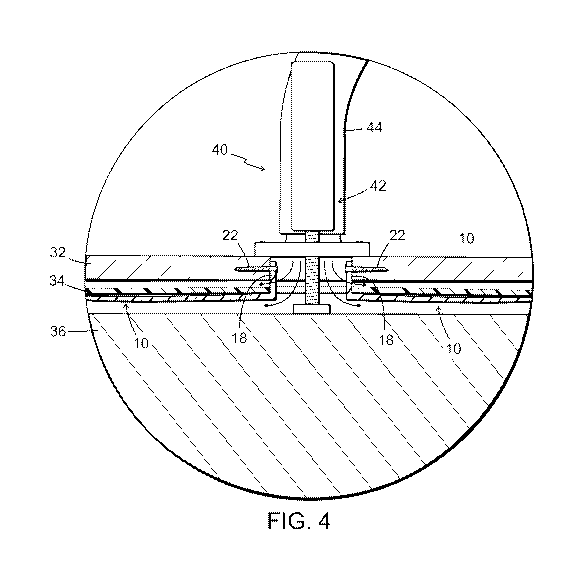Some of the information on this Web page has been provided by external sources. The Government of Canada is not responsible for the accuracy, reliability or currency of the information supplied by external sources. Users wishing to rely upon this information should consult directly with the source of the information. Content provided by external sources is not subject to official languages, privacy and accessibility requirements.
Any discrepancies in the text and image of the Claims and Abstract are due to differing posting times. Text of the Claims and Abstract are posted:
| (12) Patent Application: | (11) CA 3134104 |
|---|---|
| (54) English Title: | METHOD AND DEVICE IN A FLOOR STRUCTURE DRYING PROCESS |
| (54) French Title: | PROCEDE ET DISPOSITIF DANS UN PROCESSUS DE SECHAGE DE STRUCTURE DE PLANCHER |
| Status: | Examination |
| (51) International Patent Classification (IPC): |
|
|---|---|
| (72) Inventors : |
|
| (73) Owners : |
|
| (71) Applicants : |
|
| (74) Agent: | SMART & BIGGAR LP |
| (74) Associate agent: | |
| (45) Issued: | |
| (86) PCT Filing Date: | 2020-04-08 |
| (87) Open to Public Inspection: | 2020-10-15 |
| Examination requested: | 2024-04-04 |
| Availability of licence: | N/A |
| Dedicated to the Public: | N/A |
| (25) Language of filing: | English |
| Patent Cooperation Treaty (PCT): | Yes |
|---|---|
| (86) PCT Filing Number: | PCT/SE2020/050365 |
| (87) International Publication Number: | WO 2020209779 |
| (85) National Entry: | 2021-09-17 |
| (30) Application Priority Data: | ||||||
|---|---|---|---|---|---|---|
|
A method and device for holding a subsurface layer (34) of an elevated flooring portion of a floor structure at a distance (D) from a subfloor (36) in a vicinity of an opening in the flooring portion during a process of drying the floor structure. According to the invention there is provided at least one rod (10) having a substantially perpendicularly angled end (18). The rod (10) is inserted below the subsurface layer (34) through the opening and the angled end (18) of the rod (10) is attached to an edge of a surface layer (32) in the opening of the flooring portion in a manner that the rod (10) supports the subsurface layer at said distance from the subfloor (36) when the flooring portion (30) is elevated.
L'invention concerne un procédé et un dispositif de maintien d'une couche de sous-sol (34) d'une partie de revêtement de sol élevée d'une structure de plancher à une distance (D) d'un sous-plancher (36) à proximité d'une ouverture dans la partie de revêtement de sol pendant un processus de séchage de la structure de plancher. Selon l'invention, il est prévu au moins une tige (10) ayant une extrémité inclinée (18) sensiblement perpendiculaire. La tige (10) est insérée sous la couche de sous-sol (34) à travers l'ouverture et l'extrémité inclinée (18) de la tige (10) est fixée à un bord d'une couche de surface (32) dans l'ouverture de la partie de revêtement de sol de telle sorte que la tige (10) supporte la couche de sous-sol à ladite distance du sous-plancher (36) lorsque la partie de revêtement de sol (30) est élevée.
Note: Claims are shown in the official language in which they were submitted.
Note: Descriptions are shown in the official language in which they were submitted.

2024-08-01:As part of the Next Generation Patents (NGP) transition, the Canadian Patents Database (CPD) now contains a more detailed Event History, which replicates the Event Log of our new back-office solution.
Please note that "Inactive:" events refers to events no longer in use in our new back-office solution.
For a clearer understanding of the status of the application/patent presented on this page, the site Disclaimer , as well as the definitions for Patent , Event History , Maintenance Fee and Payment History should be consulted.
| Description | Date |
|---|---|
| Letter Sent | 2024-04-08 |
| Request for Examination Requirements Determined Compliant | 2024-04-04 |
| Request for Examination Received | 2024-04-04 |
| All Requirements for Examination Determined Compliant | 2024-04-04 |
| Maintenance Request Received | 2024-03-12 |
| Maintenance Request Received | 2023-03-20 |
| Inactive: Cover page published | 2021-12-01 |
| Letter sent | 2021-10-19 |
| Priority Claim Requirements Determined Compliant | 2021-10-18 |
| Application Received - PCT | 2021-10-18 |
| Inactive: First IPC assigned | 2021-10-18 |
| Inactive: IPC assigned | 2021-10-18 |
| Inactive: IPC assigned | 2021-10-18 |
| Inactive: IPC assigned | 2021-10-18 |
| Request for Priority Received | 2021-10-18 |
| National Entry Requirements Determined Compliant | 2021-09-17 |
| Application Published (Open to Public Inspection) | 2020-10-15 |
There is no abandonment history.
The last payment was received on 2024-03-12
Note : If the full payment has not been received on or before the date indicated, a further fee may be required which may be one of the following
Please refer to the CIPO Patent Fees web page to see all current fee amounts.
| Fee Type | Anniversary Year | Due Date | Paid Date |
|---|---|---|---|
| Basic national fee - standard | 2021-09-17 | 2021-09-17 | |
| MF (application, 2nd anniv.) - standard | 02 | 2022-04-08 | 2022-04-05 |
| MF (application, 3rd anniv.) - standard | 03 | 2023-04-11 | 2023-03-20 |
| MF (application, 4th anniv.) - standard | 04 | 2024-04-08 | 2024-03-12 |
| Request for examination - standard | 2024-04-08 | 2024-04-04 |
Note: Records showing the ownership history in alphabetical order.
| Current Owners on Record |
|---|
| REDDO FLOOR SOLUTIONS AB |
| Past Owners on Record |
|---|
| JOHAN AHSBERG |